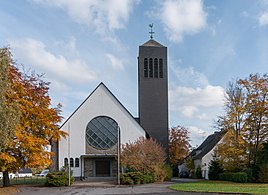Holzen (Arnsberg)
|
Wood
City of Arnsberg
|
|
|---|---|
| Coordinates: 51 ° 25 ′ 7 ″ N , 7 ° 54 ′ 53 ″ E | |
| Height : | 258 m |
| Area : | 25.49 km² |
| Residents : | 1974 (Dec. 31, 2018) |
| Population density : | 77 inhabitants / km² |
| Incorporation : | 1st January 1975 |
| Postal code : | 59757 |
| Area code : | 02932 |
|
Church of St. Johannes Ev. in wood
|
|
Holzen is a district of the city of Arnsberg in the Hochsauerlandkreis with 1974 inhabitants. In order to avoid confusion with places of the same name, it was also called “Holzen vorm Luer” in the past.
Location and structure
The village lies west of the Lüerwald . Until the local reorganization, Holzen was an independent municipality. The Stiepel estate is located in the village itself. There are numerous farms and small villages around the place (Ainkhausen, Alringen, Deinstrop, Dreisborn, Kirchlinde, Retringen, Wenningen, Wettmarsen). The village of Oelinghauser Heide and the Oelinghausen monastery also belong to Holzen, which is one of the largest districts of Arnsberg in terms of area with 25.45 km². Holzen is in the west of the city of Arnsberg. The Herdringen district is to the east of Holzen, and the Vosswinkel district to the north . To the northwest the place borders on the city of Menden (Sauerland) and to the south on the city of Balve .
history
Barrows and graves from prehistoric times have been found near the Effenberg. The place itself was first mentioned in 1173 as Holthusen in connection with a court transfer to the Wedinghausen monastery . The actual core of the place is made up of four farms, later other smaller properties were added. For the year 1815 the population is estimated to be 240. In addition to the farmers, there were also rural lower classes living in the village, who often made a living from traveling crafts.
As an administrative unit beyond the core town, Holzen emerged after 1803 under the rule of Hesse as a mayor's district , which in turn was subordinate to the mayor's office of Neheim . In 1837 Holzen became part of the newly established Hüsten Office as a political municipality . At that time Holzen had about 850 inhabitants. Without any notable industrial development and without a connection to the railroad, growth remained low. In 1914, the population of 848 was almost as large as in the first half of the 19th century. In 1936 the population had grown to 931.
It was not until after the Second World War that bus traffic and individual motorization, and thus opportunities for commuting, increased the population. As early as 1966, 1,478 people were living in the community, around half of them in the core town. By 1997 the population had grown to just over 2000.
The place was the location of the SAS Arnsberg-Holzen .
On January 1, 1975, Holzen was incorporated into the city of Arnsberg.
politics
coat of arms

|
Blazon : In blue, a silver key turned right with a silver palm branch placed in the St. Andrew's cross. Description: The key and the palm branch refer to the former Oelinghausen monastery , whose former monastery church (consecrated to Saint Peter) now serves as the parish church for the community. The colors blue and silver are hallmarks of the former sovereign, the Count of Arnsberg . The coat of arms was officially approved on July 11, 1962. |
literature
- * Ferdy Fischer et al .: Arnsberg. Pearl of the Sauerland, city of lights. Genster, Menden around 1990, p. 11f.
Web links
- Site of the place
- Holzen (Arnsberg) in the Westphalia Culture Atlas
Sources and individual references
- ↑ City of Arnsberg: Residents main and secondary residence by district , accessed on June 20, 2019
- ^ Federal Statistical Office (ed.): Historical municipality directory for the Federal Republic of Germany. Name, border and key number changes in municipalities, counties and administrative districts from May 27, 1970 to December 31, 1982 . W. Kohlhammer, Stuttgart / Mainz 1983, ISBN 3-17-003263-1 , p. 330 .
- ^ Eduard Belke, Alfred Bruns, Helmut Müller: Kommunale Wappen des Herzogtums Westfalen, Arnsberg 1986, p. 154 ISBN 3-87793-017-4

